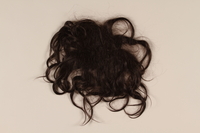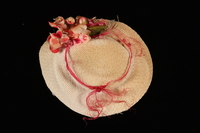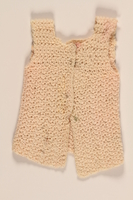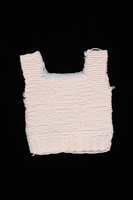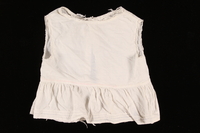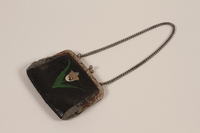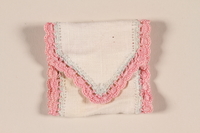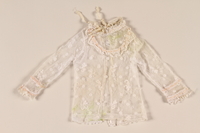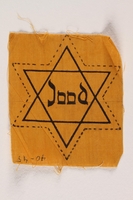Overview
- Brief Narrative
- The mask was used before World War II.
- Credit Line
- United States Holocaust Memorial Museum Collection, Gift of Julia Schor
Physical Details
- Classification
-
Decorative Arts
- Category
-
Papercrafts
- Object Type
-
Masks (lcsh)
- Physical Description
- The mask has gold-colored sequins attached to a fabric background with two string ties. It is designed to cover only the eyes of the wearer.
- Materials
- overall : cloth, metal
Rights & Restrictions
- Conditions on Access
- No restrictions on access
- Conditions on Use
- No restrictions on use
Administrative Notes
- Legal Status
- Permanent Collection
- Provenance
- The mask was donated to the United States Holocaust Memorial Museum in 2002 by Julia Schor.
- Record last modified:
- 2022-07-28 18:28:24
- This page:
- https://collections.ushmm.org/search/catalog/irn511959
Download & Licensing
In-Person Research
- By Appointment
- Request 21 Days in Advance of Visit
- Plan a Research Visit
- Request to See This Object
Contact Us
Also in This Collection
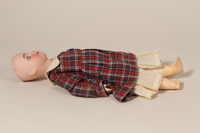
Porcelain doll with dress
Object
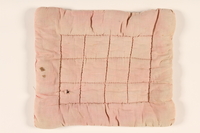
Pink pillow
Object
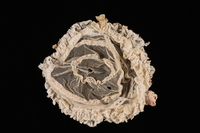
Lace netting baby bonnet worn during bris in prewar Vienna
Object
Bonnet worn by Herbert Mauthner, during his circumcision in Vienna, Austria. Julia Schor was born Betty Julia Ensel on April 4, 1937,to a non-Jewish German mother, Rose Marie Schink, and a Jewish father, Guy Weinberg, in Amsterdam, Netherlands. During World War II, Rose Marie Schink hid 12 Jews in the attic of her house in Blaricum, Netherlands, and was in contact with the Dutch resistance movement. Julia attended school under her mother's maiden name in order to avoid suspicion about her Jewish ancestry. Julia, her mother, and all of the Jews hiding in their house were liberated in May 1945.
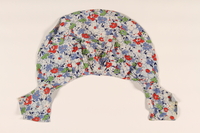
Hat
Object
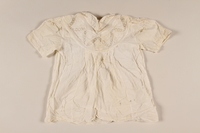
Child's white cotton dress with lace and embroidery
Object
Julia Schor wore the dress during World War II.
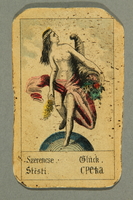
Tarot cards
Object
Julia Schor played with the cards while she was in hiding during the Holocaust in the Netherlands.
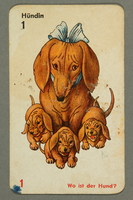
Children's playing cards
Object
Julia Schor played with the cards while she was in hiding during the Holocaust in the Netherlands.
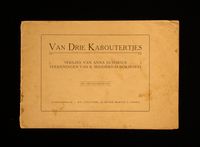
Book
Object
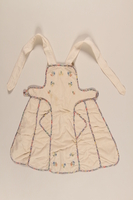
Apron
Object
The apron was made for Julia Schor while she was in hiding as a child in the Netherlands during the Holocaust.
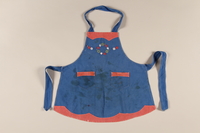
Apron
Object
The apron was made for Julia Schor while she was in hiding as a child in the Netherlands during the Holocaust.
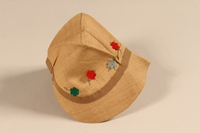
Hat
Object
The hat was worn by Julia Schor while she was in hiding as a child in the Netherlands during the Holocaust.

Book
Object
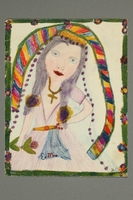
Two-sided crayon drawing of a girl wearing a cross created by a young girl living in hiding
Object
Double-sided drawing made by Betty Julia Ensel while she was living under an assumed identity in the Netherlands. One side depicts a girl in a dress wearing a cross; the drawing on the opposite side portrays 6 girls. When Germany occupied the Netherlands in May 1940, three year old Julia lived in Amsterdam with her parents, Rose Marie Schink, who was not Jewish, and Guy Weinberg, who was Jewish. Rose Marie hid twelve Jews in the attic of her house in Blaricum and was in contact with the Dutch resistance movement. Julia attended school under her mother's maiden name in order to avoid suspicion about her Jewish ancestry. Julia, her mother, and all of the Jews hiding in their house were liberated in May 1945.
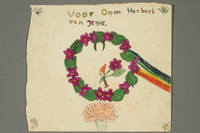
Crayon drawing of a green leaved wreath with purple flowers made by a young girl while living in hiding
Object
Crayon drawing made by Betty Julia Ensel while she was living in hiding in the Netherlands. It depicts a wreath of green leaves and purple flowers. When Germany occupied the Netherlands in May 1940, three year old Julia lived in Amsterdam with her parents, Rose Marie Schink, who was not Jewish, and Guy Weinberg, who was Jewish. Rose Marie hid twelve Jews in the attic of her house in Blaricum and was in contact with the Dutch resistance movement. Julia attended school under her mother's maiden name in order to avoid suspicion about her Jewish ancestry. Julia, her mother, and all of the Jews hiding in their house were liberated in May 1945.
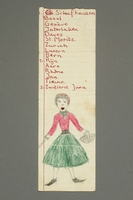
Crayon drawing of a girl with a basket created by a young girl while living in hiding
Object
Crayon drawing made by Betty Julia Ensel while she was living in hiding in the Netherlands. It depicts a girl holding a basket and a list of cities. When Germany occupied the Netherlands in May 1940, three year old Julia lived in Amsterdam with her parents, Rose Marie Schink, who was not Jewish, and Guy Weinberg, who was Jewish. Rose Marie hid twelve Jews in the attic of her house in Blaricum and was in contact with the Dutch resistance movement. Julia attended school under her mother's maiden name in order to avoid suspicion about her Jewish ancestry. Julia, her mother, and all of the Jews hiding in their house were liberated in May 1945.
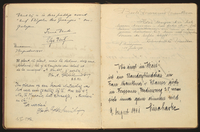
Julia Schor papers
Document
The Julia Schor papers consist of biographical materials, clippings, a guest books, a library catalog, and a memoir documenting Schor’s childhood in Amsterdam, the Nazi occupation of the Netherlands, being disguised as a Gentile in Blaricum, the work of her mother, Rosemarie Ensel, work for the Dutch Resistance, and the Jewish people her mother hid in their attic. Biographical materials include a poem about Christmas in wartime, a certificate supporting Rosemarie’s efforts to obtain a visa, a receipt for seizure of property, and three records documenting Judah Ensel’s efforts to retrieve jewelry from Rosemarie. Clippings include a chronicle of major World War II events of 1943, a description of Rosemarie Mauthner’s receipt of the Resistance memorial cross in 1983, and three videos chronicling Dutch resistance during World War II that were shown in 1990. The guest book belonged to Melanie Mauthner, who began the book in Vienna in 1928, continued in the Netherlands in 1938, and brought it with her into hiding. The library catalog and drawing of a library lists the books in Rosemarie’s personal library was probably created by someone hiding in Rosemarie’s attic in 1944. Julia Schor’s memoir, Mamma's Ark, details her mother’s childhood in Meuselwitz and romantic life in Germany and the Netherlands, her own childhood in Amsterdam, the German invasion of the Netherlands in 1941, a visit to her German grandparents in Groszbuch in 1942, moving to Blaricum during the Nazi occupation, enrollment in the local school as a non-Jew, her mother’s work in the Dutch Resistance, the Jewish people her mother hid in the attic, SS raids, and liberation.
Dance card
Object
The dance card consists of a small booklet with an intricately decorated cover and a pencil hanging from a cord at the side. Dance cards, or "Ballspenden," were especially popular at balls in Vienna, Austria, during the nineteenth and early twentieth centuries. They were used to list, in order, the names of the partners with whom a woman had agreed to dance at a formal ball or party.

